History and Techniques of a Polychrome Wooden Statue, How an Integrated Approach Contributes to Resolving Iconographic Inconsistencies
Abstract
:1. Introduction
2. Materials and Methods
3. Results and Discussion
3.1. Description and Conservation State
3.2. Wood Identification
3.3. Identification of Pigments and Executive Technique
4. Conclusions
Supplementary Materials
Author Contributions
Funding
Institutional Review Board Statement
Informed Consent Statement
Data Availability Statement
Acknowledgments
Conflicts of Interest
References
- Masala, C. Il culto di Nostra Signora d’Itria in Sardegna. La storia, le tradizioni, le località; Aìsara: Cagliari, Italy, 2008; pp. 1–696. ISBN 886104025X. (In Italian) [Google Scholar]
- Porcella, M.F. Iconografia e culto di Nostra Signora D’Itria nella Sardegna Spagnola. ArcheoArte 2012, 1, 687–701. [Google Scholar]
- Scano, M.G. Pittura e Scultura del ‘600 e del ‘700; Ilisso: Nuoro, Italy, 1991; ISBN 88-85098-13-4. (In Italian) [Google Scholar]
- Artoni, P. Il Santuario della Beata Vergine delle Grazie: Inedite carte d’archivio per la storia dell’impalcato ligneo. In Accademia Nazionale Virgiliana di Scienze Lettere e Arti, Atti e memorie; Nuova Serie LXXIII: Mantova, Italy, 2005; pp. 27–80. (In Italian) [Google Scholar]
- Agresti, G.; Castorina, R.; Genco, G.; Giagnacovo, C.; Lo Monaco, A.; Pelosi, C. Wood of chestnut in Cultural Heritage. Acta Hortic. 2010, 866, 51–57. [Google Scholar] [CrossRef]
- Di Lodovico, D. Revising Devotion: The Role of Wooden Sculptures in Affecting Painting and Devotion in the Late Medieval Period in Italy (XII-XV century). Ph.D. Thesis, University of Washington, Seattle, WA, USA, 2016; 394p. [Google Scholar]
- Lo Monaco, A.; Giagnacovo, C.; Falcucci, C.; Pelosi, C. The triptych of the Holy Saviour in the Tivoli cathedral: Diagnosis, conservation and religious requirements. Eur. J. Sci. Theol. 2015, 11, 73–84. [Google Scholar]
- Lo Monaco, A.; Micheli, M.; Orellana, J.A.; Schirone, A. Consagrada imagen de Jesus Nazareno of Sonsonate. A xylological study of the wooden sculpture support. Eur. J. Sci. Theol. 2017, 13, 41–49. [Google Scholar]
- Lo Monaco, A.; Marabelli, M.; Pelosi, C.; Salvo, M. The Altar Machine in the Church Mother of Gangi (Palermo, Italy). Interpretation of the past uses, scientific investigation and preservation challenge. Chem. Cent. J. 2012, 6, 47. [Google Scholar] [CrossRef]
- Avanzati, D.; Saccuman, R.; Agresti, G.; Faieta, R.; Caliano, E.; Pelosi, C.; Lo Monaco, A. Multidisciplinary approach for the conservation of the Casoli tryptich. Eur. J. Sci. Theol. 2020, 16, 207–216. [Google Scholar]
- Kumar, S.V.; Singh, M.; Wagh, S.W.; Mahajan, N.E. Polychrome Sculptures of St. Francis of Assisi Church, Old Goa: A challenge in scientific conservation. Int. J. Conserv. Sci. 2015, 6, 465–472. [Google Scholar]
- Pelosi, C.; Lo Monaco, A.; Bernabei, M.; Agresti, G.; Colantonio, C.; Perri, A.; Comelli, D.; Valentini, G.; Manzoni, C. Beyond the visible: The Viterbo Crucifixion panel painting attributed to Michelangelo Buonarroti. Microchem. J. 2020, 154, 1046368. [Google Scholar] [CrossRef]
- Paoletti, J.T. Wooden Sculpture in Italy as Sacral Presence. Artibus Hist. 1992, 13, 85–100. [Google Scholar] [CrossRef]
- Auffret, S.; Nikolaus, S.B. Cleaning of Wooden Gilded Surfaces an Experts Meeting Organized by the Getty Conservation Institute, 12–14 March 2018; Getty Conservation Institute: Los Angeles, CA, USA, 2019. [Google Scholar]
- Pelosi, C.; Balletti, F.; Agresti, G.; Lo Monaco, A. Diagnostic investigation through minimal sampling for religious artworks knowlwdge. Eur. J. Sci. Theol. 2019, 15, 223–235. [Google Scholar]
- Burgio, L.; Gregory, T. Protocol for the Analysis of Cross-Sections from Gilded Surfaces. Heritage 2021, 4, 2416–2430. [Google Scholar] [CrossRef]
- Franquelo, M.L.; Duran, A.; Castaing, J.; Arquillo, D.; Perez-Rodriguez, J.J. XRF, μ-XRD and μ-spectroscopic techniques for revealing the composition and structure of paint layers on polychrome sculptures after multiple restorations. Talanta 2012, 89, 462–469. [Google Scholar] [CrossRef] [PubMed]
- Nardi Berti, R. Contributi scientifico-pratici per una migliore conoscenza ed utilizzazione del legno. In La Struttura Anatomica del Legno ed il Riconoscimento dei Legnami Italiani di Più Corrente Impiego; CNR-Istituto del Legno: Firenze, Italy, 1993; p. 155. (In Italian) [Google Scholar]
- Schweingruber, F.H. Microscopic Wood Anatomy: Structural Variability of Stems and Twigs in Recent and Subfossil Woods from Central Europe; Swiss Federal Institute for Forest, Snow and Landscape Research: Birmensdorf, Switzerland, 1990; p. 226. [Google Scholar]
- Lo Monaco, A.; Balletti, F.; Pelosi, C. Wood in Cultural Heritage. Properties and conservation of historical wooden artefacts. Eur. J. Sci. Theol. 2018, 14, 161–171. [Google Scholar]
- Wheeler, E.A.; Baas, P.; Gasson, P.E. IAWA List of microscopic features for Hardwood identification. IAWA Bullettin. 1989, 10, 219–332. [Google Scholar] [CrossRef]
- Sandu, I.C.A.; Schäfer, S.; Magrini, D.; Bracci, S.; Roque, C.A. Cross-Section and Staining-Based Techniques for Investigating Organic Materials in Painted and Polychrome Works of Art: A Review. Microsc. Microanal. 2012, 18, 860–875. [Google Scholar]
- Pasolini, A. Contributo allo studio della statuaria in ‘estofado de oro’. In “Oltre Longhi”: Ai confini dell’Arte Scritti per gli ottant’anni di Francesco Abbate; Cleopazzo, N., Panarello, M., Eds.; Centro Studi sulla civiltà artistica dell’Italia meridionale “Giovanni Previtali”: Roccagloriosa (SA), Italy, 2020; pp. 85–92. (In Italian) [Google Scholar]
- Giordano, G. Tecnologia del legno. In Vol I–La Materia Prima, Vol III-I legnami del Mondo; UTET: Torino, Italy, 1981. (In Italian) [Google Scholar]
- Jacquiot, C.; Trenard, Y.; Dirol, D. Atlas D’anatomie des Bois des Angiospermes; CTDB and CNRS: Paris, France, 1973. (In French) [Google Scholar]
- Marette, J. Connaissance des Primitifs par L’étude du Bois du XII au XVI Siècle; Editions A. & J. Picard: Paris, France, 1961; pp. 1–383. (In French) [Google Scholar]
- Fidanza, G. Caratteristiche tecnologiche e formali delle specie legnose: Una verifica su statue e intagli di età moderna. In Statue di Legno. Caratteristiche Tecnologiche e Formali delle Specie Legnose; Istituto Poligrafico e Zecca dello Stato: Roma, Italy, 2008; pp. 33–57. (In Italian) [Google Scholar]
- Macchioni, N.; Fachechi, G.M.; Lazzeri, S.; Sozzi, L. Timber species and provenances of wooden sculptures. Information from the collections of the National Museum of “Palazzo di Venezia” in Rome. J. Cult. Herit. 2015, 16, 57–64.
- Borghini, G.; Massafra, M.G. Legni da Ebanisteria; De Luca Editori d’Arte: Roma, Italy, 2002. (In Italian) [Google Scholar]
- Mazzanti, P.; Togni, M.; Uzielli, L. Drying shrinkage and mechanical properties of poplar wood (Populus alba L.) across the grain. J. Cult. Herit. 2012, 13, S85–S89. [Google Scholar] [CrossRef]
- Macchioni, N.; Lazzeri, S.; Sozzi, L.; Vitiello, R. Wooden sculptures from XVII and XVIII centuries in the region of Asti (Italy): Scientific identification of the species. Int. J. Conserv. Sci. 2011, 2, 251–260. [Google Scholar]
- Bernabei, M.; Capra, N.; Giovannini, L.; Tomasi, M.L. Flying on wood and fabric: The tree species used for the construction of the Ansaldo A.1 “Balilla” biplane (1918). Archaeometry 2021, 64, 256–264. [Google Scholar] [CrossRef]
- Gellini, R.; Grossoni, P. Botanica Forestale, Vol. 2: Angiosperme; CEDAM: Firenze, Italy, 1997. (In Italian) [Google Scholar]
- Corona, E. Xylology: Technical, historical, philological involvements. Ann.-Accad. Ital. Sci. For. 1991, 10, 211–236. (In Italian) [Google Scholar]
- Bernabei, M.; Macchioni, N.; Pizzo, B.; Sozzi, L.; Lazzeri, S.; Fiorentino, L.; Pecoraro, E.; Quarta, G.; Calcagnile, G. The wooden foundations of Rialto Bridge (Ponte di Rialto) in Venice: Technological characterisation and dating. J. Cult. Herit. 2019, 36, 85–93. [Google Scholar] [CrossRef]
- Larsen, R.; Coluzzi, N.; Cosentino, A. Free XRF Spectroscopy Database of Pigments Checker. Int. J. Conserv. Sci. 2016, 7, 659–668. [Google Scholar]
- Hochleitnera, B.; Desnica, V.; Mantlera, M.; Schreinerb, M. Historical pigments: A collection analyzed with X-ray diffraction analysis and X-ray fluorescence analysis in order to create a database. Spectrochim. Acta B 2003, 58, 641–649. [Google Scholar] [CrossRef]
- Helwig, K. Iron oxide pigments: Natural and synthetic. In Artists’ Pigments, a Handbook of their History and Characteristics; Berrie, B.H., Ed.; Archetype Publication: London, UK, 2007; Volume 4, pp. 39–109. [Google Scholar]
- Croll, S. Oview of Developments in the Paint Industry since 1930. In Modern Paints, Uncovered Proceeding of Modern Paints Uncovered Symposium, London, United Kingdom, 16–19 May 2006; Learner, T.J.S., Smihen, P., Kruger, J.W., Schillig, M.R., Eds.; The Getty Conservation Institute: Los Angeles, CA, USA, 2006; pp. 17–29. [Google Scholar]
- Lalli, C.G.; Innocenti, F. La doratura nelle tecniche artistiche. OPD Restauro 2016, 48, 340–348. (In Italian) [Google Scholar]
- Costa, V. The deterioration of silver alloys and some aspects of their conservation. Stud. Conserv. 2013, 46, 18–34. [Google Scholar] [CrossRef]
- Unger, A. Decontamination and “deconsolidation” of historical wood preservatives and wood consolidants in cultural heritage. J. Cult. Herit. 2012, 13S, S196–S202. [Google Scholar] [CrossRef]
- Mühlethaler, B.; Thissen, J.S. Artists’ Pigments, a Handbook of Their History and Characteristics; Roy, A., Ed.; National Gallery of Art: Washington, DC, USA, 1993; Volume 2, pp. 113–130. [Google Scholar]
- Burnstock, A.; Learne, T. Changes in the surface characteristics of artificially aged mastic varnishes after cleaning using alkaline reagents. Stud. Conserv. 1992, 37, 165–184. [Google Scholar]
- Sandu, I.C.A.; de Sa, M.H.; Pereirac, M.C. Ancient ‘gilded’ art objects from European cultural heritage: A review on different scales of characterization. Surf. Interface Anal. 2011, 43, 1134–1151. [Google Scholar] [CrossRef]
- Sandu, I.C.A.; Afonso, L.U.; Murta, E.; De Sa, M.H. Gilding techniques in religious art between East and West 14th-18th centuries. Int. J. Conserv. Sci. 2010, 1, 47–62. [Google Scholar]
- Cennini, C. The Craftsman’s Handbook—The Italian “Il libro dell’arte”; Thompson, D.V., Translator; Dover Publications: New York, NY, USA, 1954. [Google Scholar]
- Cerasuolo, A. Estofado e policromie: Osservazioni sulla tecnica attraverso la testimonianza di Francisco Pacheco. Boll. D’arte 2011, 8, 147–160. (In Italian) [Google Scholar]
- Scano, M.G.; Messina, M.G. Estofado de Oro: La Statuaria Lignea Nella Sardegna Spagnola, Exhibition Catalogue (Cagliari-Sassari, Italy, 2001–2002); Exmà: Cagliari, Italy, 2001. (In Italian) [Google Scholar]
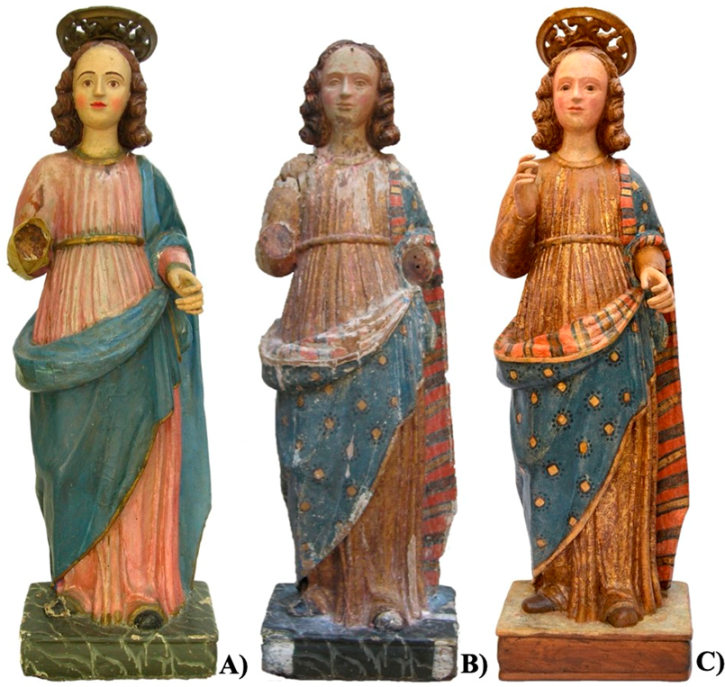
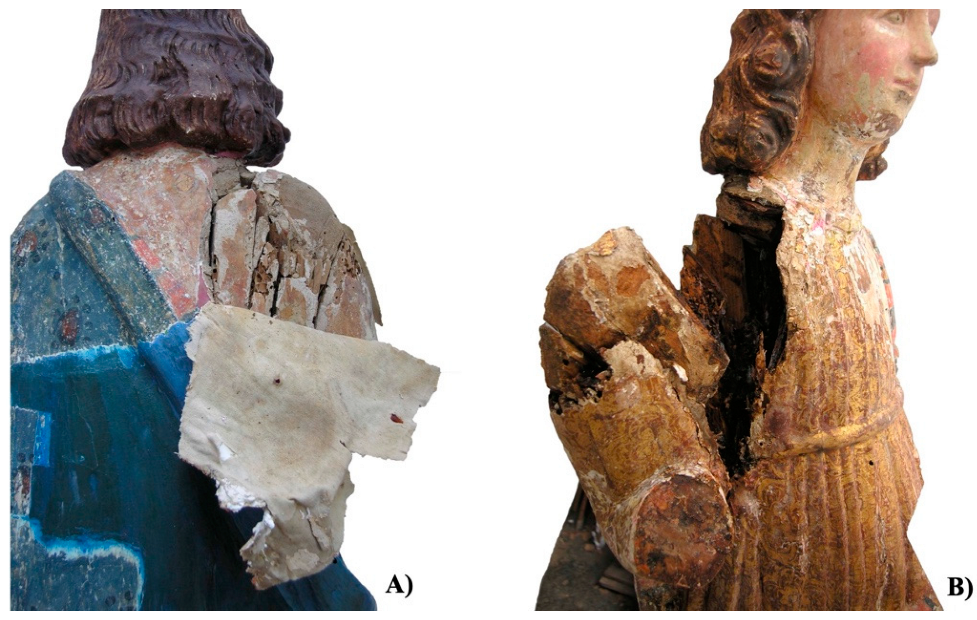
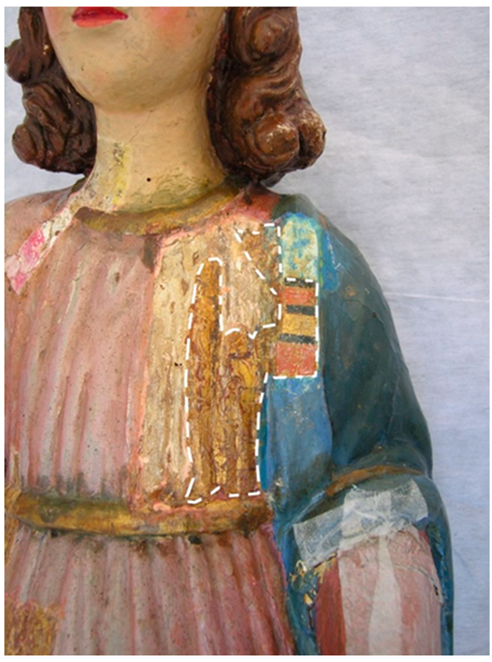
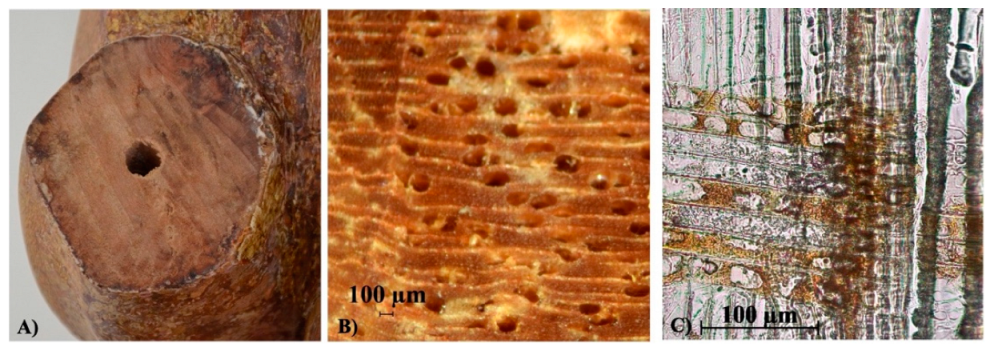

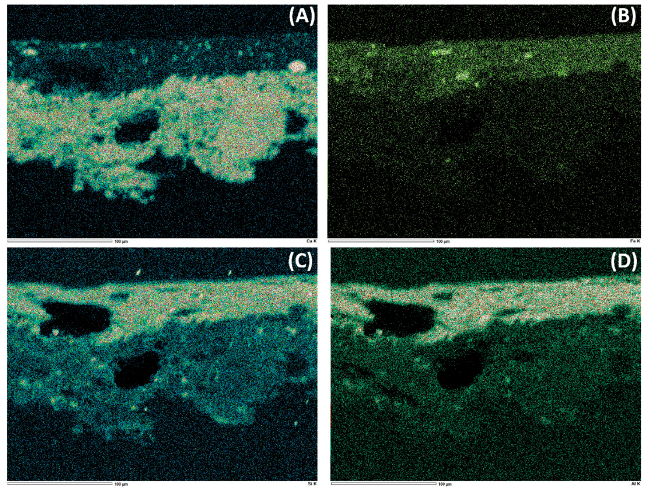
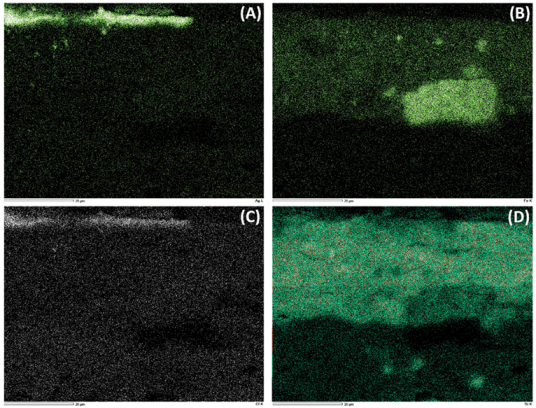
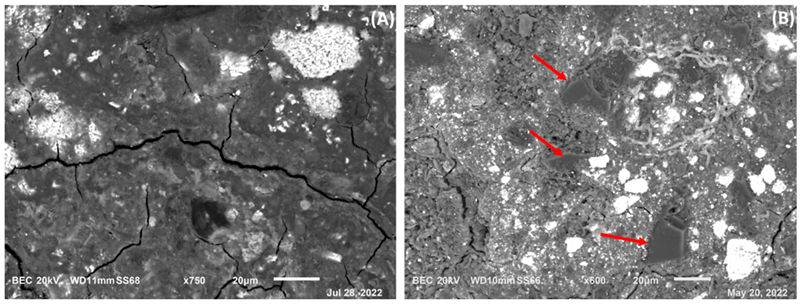
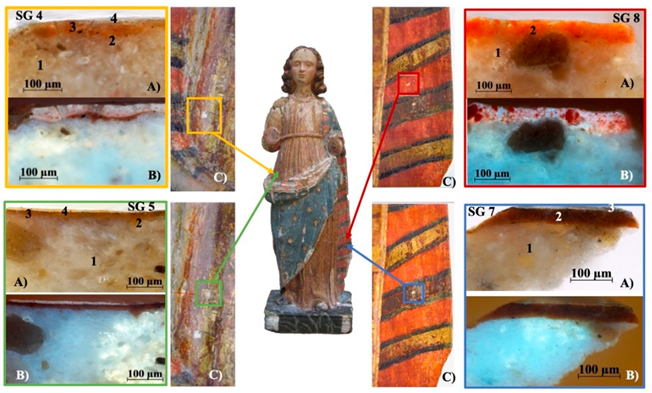


| Sample | Description | Scientific Investigations |
|---|---|---|
| SG1 | Blue from the quadrangular shaped base | XRF |
| SG2 | Red from the quadrangular shaped base | XRF, FTIR |
| SG3 | Blue from the quadrangular shaped base | XRF, FTIR, SEM-EDS |
| SG4 | Orange from the robe mantle | XRF, cross section, FTIR |
| SG5 | Gilding from the robe | XRF, cross section |
| SG6 | Brown from the robe | XRF, cross section, FTIR, SEM-EDS |
| SG7 | Brown, turn-up of the mantle | XRF, cross section, FTIR, SEM-EDS |
| SG8 | Orange, turn-up of the mantle | XRF, cross section, FTIR, SEM-EDS |
| SG9 | Blue from the mantle | XRF, SEM-EDS |
| SG10 | Blue from the mantle’s embroidery | XRF, FTIR, SEM-EDS |
| SG11 | Wood, arm, not painted | Optic Microscope |
| Sample | Detected Elements | Note on Probable Pigment |
|---|---|---|
| SG1 | Cu (main), Pb, Fe, Ca | Cu-based pigment |
| SG2 | Pb (main), Ca, Zn, K, As, Cu (tr) | Pb-based red, probably minium |
| SG3 | Pb (main), Ca, Fe, Co, Ni, Ti, Cl, S (tr) | Probable smalt blue with lead white |
| SG4 | Ca (main), Pb, Fe, Cl, Cu, Ti, Au (tr) | Gold on priming |
| SG5 | Fe (main), Pb, Ca, Au, Ti (tr) | Gold on priming |
| SG6 | Fe (main), Ti, Ca | Iron-based pigments |
| SG7 | Ca (main), Fe, Pb, Ti, Cu | Iron-based pigments with traces of probable repainting |
| SG8 | Pb (main), Ca, Ti (tr) | Pb-based pigment probably minium |
| SG9 | Pb (main), Co, As, Ni, Fe | Blue smalt and lead white |
| SG10 | Pb (main), Ca, Fe, As | Pb based pigment, traces of smalt |
Publisher’s Note: MDPI stays neutral with regard to jurisdictional claims in published maps and institutional affiliations. |
© 2022 by the authors. Licensee MDPI, Basel, Switzerland. This article is an open access article distributed under the terms and conditions of the Creative Commons Attribution (CC BY) license (https://creativecommons.org/licenses/by/4.0/).
Share and Cite
Lo Monaco, A.; Agresti, G.; Serusi, G.; Taddei, A.R.; Pelosi, C. History and Techniques of a Polychrome Wooden Statue, How an Integrated Approach Contributes to Resolving Iconographic Inconsistencies. Heritage 2022, 5, 2488-2503. https://doi.org/10.3390/heritage5030129
Lo Monaco A, Agresti G, Serusi G, Taddei AR, Pelosi C. History and Techniques of a Polychrome Wooden Statue, How an Integrated Approach Contributes to Resolving Iconographic Inconsistencies. Heritage. 2022; 5(3):2488-2503. https://doi.org/10.3390/heritage5030129
Chicago/Turabian StyleLo Monaco, Angela, Giorgia Agresti, Giovanna Serusi, Anna Rita Taddei, and Claudia Pelosi. 2022. "History and Techniques of a Polychrome Wooden Statue, How an Integrated Approach Contributes to Resolving Iconographic Inconsistencies" Heritage 5, no. 3: 2488-2503. https://doi.org/10.3390/heritage5030129
APA StyleLo Monaco, A., Agresti, G., Serusi, G., Taddei, A. R., & Pelosi, C. (2022). History and Techniques of a Polychrome Wooden Statue, How an Integrated Approach Contributes to Resolving Iconographic Inconsistencies. Heritage, 5(3), 2488-2503. https://doi.org/10.3390/heritage5030129









